Middle Eastern Dragons page, transferred over from the old site (circa 2009).
Table of Contents
History
Famous Dragons
Babylonian Dragons
Canaanite, Hebrew Dragons
Egyptian Dragons
Iranian Dragons
History of Middle Eastern Dragons
Introduction
Middle Eastern dragons and serpents were fearsome creatures of tremendous strength and size. They often exhibited the characteristics of other animals, such as the head of a lion and the talons of an eagle. Some are even depicted with a scorpion’s tail.
Many were sea creatures, embodying the destructive power of unpredictable nature and the threat of chaos. In time, they came to represent not just disorder, but evil. As the religions of the Middle East moved into Europe, their views of serpents and dragons most likely influenced the West’s depiction of the dragon as being a symbol of evil as well.
RELATED: Persian dragon art
Symbols of Middle Eastern Dragons
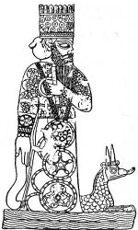
Many Middle Eastern dragons were a symbol of Marduk, the supreme god of Babylonian and Assyrian religion, originally the god of thunderstorms with the Amonites, and the guardian god of the city of Babylon itself.
As the sacred animal of the dragon, Marduk had the head and tail of a serpent, the body and forelegs of a lion and the hind legs of a falcon, with a forked tongue. Marduk was emblazoned on the monumental Ishtar Gate at the climax of the ceremonial route through the city [King Nebuchadnezzar’s siege of Jerusalem, 2 Kings 24:10-16]. The processional way was also lined with rows of lions sacred to Ishtar, the goddess of love and fertility.
The most dramatic myths concern human or immortal heroes who killed dragons that threatened the world. By destroying the monsters, heroes were able to restore order and preserve the safety of civilisation.
Draco in the Stars
Dragons also made appropriate emblems for the stars mapped by Arabic astronomers. These cosmic creatures engaged in battles far beyond human realms, such as the encounter between the Persian hero Feridun and the mighty dragon Azhi Dahaka. When Feridun stabbed the monster, snakes, toads and scorpions began to pour out, so instead of cutting him up, the hero imprisoned him in Mount Demavend.
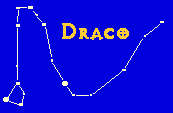
The oldest legend about Draco comes from the Sumerians and Babylonians of the Tigris and Euphrates Valley more than 5,000 years ago.
Its many stars were the 42 heavenly judges, namely Osiris and his assistants, among them ibis-headed Thoth, and the jackal-headed Anubis.
Draco’s head was the Hall of Justice or Judgement Hall. Its four corner stars – Rastaban, Eltanin, Grumium and Kuma, were the four incorruptible sons of Horus: Imsety, Hapi, Duamutef and Kebehsenuf, who watched over Upper Egypt. In July, when the Nile rose, the head of Draco stood high in the sky at midnight, watching over Upper Egypt.
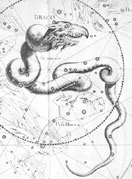
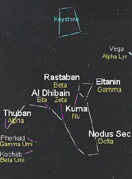
References:
> The Constellations
> Chandra X-Ray Observatory Center
Famous Middle Eastern Dragons
Here are some famous middle eastern dragons from the region!
Famous Babylonian Dragons
– Apsu was the universal primeval father, the serpent god of fresh water. He spread happiness and abundance over Earth and was the source of wisdom and knowledge. The union of Apsu and Tiamat gave rise to all the great gods and goddesses of Babylon, and both represent the idea of chaos that precedes form and order, which is the foundation on which civilization rests. In time Apsu became troubled with the clamour of the young gods. He plotted with Tiamat to destroy them. Tiamat was at first unwilling to take part in the battle, but the god Ea struck first and destroyed him, driving Tiamat to seek revenge.
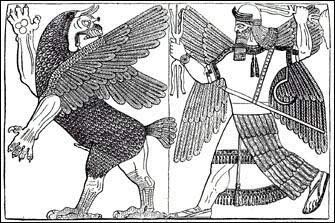
– This glazed black brick relief shows a striding dragon, sacred to the god Marduk [a.k.a the sirrush]. It is a portion of the decoration from one of the city gates of Babylon. King Nebuchadnezzar, whose name appears as the ruler of Jerusalem in the Bible [Kings II 24:10-16, 25:8-15], ornamented the monumental entrance gate dedicated to Ishtar, the goddess of love and fertility.
Marduk was originally regarded as a fertility or agricultural deity, but gained a reputation as a fearless warrior and this grew to such an extent that he was called upon to attack the terrifying Tiamat. He was awarded 50 titles after killing her, and in this way he absorbed all the other gods and came to symbolise total divinity, becoming the chief god of Babylon.
– [Sumerian] Zu [also known as Asag/Anzu] was an evil lesser-god in Babylonian mythology, who is also known as a demonic tempest bird and a storm-bird. He stole the Tablets of Destiny/Law from the great god Enlil, Lord of the Wind. He flew away to his mountain with these tablets that regulated the order in the universe. The god Marduk succeeded in overcoming Zu and thus retrieved the tablets. Some versions tell of Zu being overcome by Ninurta, Enlil’s son and the god of war. The world was hence prevented from returning to its prior state of primordial chaos.
References:
Books –
1. Ultimate Encyclopedia of Mythology
by Arthur Cotterell & Rachel Storm
2. Dragons: A Natural History by Dr. Karl Shuker
Websites –
> Creation Stories
> Tiamat article, Encyclopedia Mythica
Famous Canaanite, Hebrew Dragons
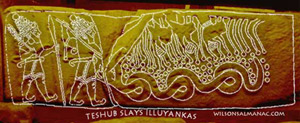
– [Canaanite] Illuyankas was a great dragon from Hittite* mythology, the Hittite version of the ‘World Serpent’. Illuyankas initially defeated the storm-god Taru, his nemesis, and ripped out his eyes and heart. In one version, the storm-god had the goddess Inaras hold a great banquet for Illuyankas and his brood. When they had fallen asleep, they were pounced upon by the storm-god, accompanied by the other gods, and subsequently killed. In yet another version, Taru had his son marry the daughter of Illuyankas, the dowry of which included the return of Taru’s eyes and heart. This effectively brought about the slaying of Illuyankas. The Hittites read this myth on New Year’s Day, and the ritual of his defeat is cited every spring to symbolise the earth’s renewal.
* The Hittites were a non-Semitic people inhabiting Canaan before it was settled by the Israelites. They invaded and settled Asia Minor at the beginning of the third millenium B.C., establishing an empire which lasted until around 1225 B.C.
– [Canaanite] Yam-nahar [also known as Yam/Yamm/Jamm] is sometimes associated with Lotan, the seven-headed serpent. Yam-nahar has much in common with the sea monster Leviathan. He has also been described as being a seven headed sea dragon that was destroyed by the young god Baal. Baal was a fertility god, and after equipping himself with magical weapons and slaying Yam-nahar, he was crowned king by the supreme god El. The tale symbolises nature’s chaotic forces being overcome by the civilising aspect, which ensures the fertility of crops.
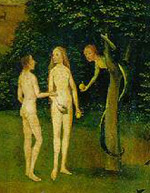
– [Hebrew] The Serpent in the Garden of Eden is frequently portrayed with the face of Lilith, who was Adam’s first wife in Hebrew legend. She considered herself his equal and left him and Eden rather than submit to him. She was often depicted as winged, having the body of a snake, and was said to be the temptress of Eve. She acquired the character of a wicked demon who killed new-born babies and was the enemy of mankind.
References:
Books –
1. Ultimate Encyclopedia of Mythology
by Arthur Cotterell & Rachel Storm
Websites –
> The Serene Dragon
> Illuyankas article, Encyclopedia Mythica
> The Circle of the Dragon
> Garden of Eden Gallery
Famous Egyptian Dragons
– Aker, was a dragon representing the Earth. It bound the coils of Apep. It was believed to preside over the point where the eastern and western horizons of the Underworld met. Aker aids the forces of light by binding and chaining the serpent when Ra passes through the underworld.
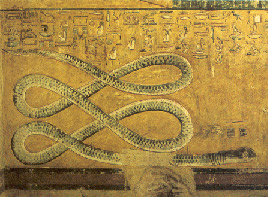
– Apep [also known as Apophis], a terrifying great sea-serpent, lay in wait in the Egyptian underworld to ambush the sun god, Ra, who had to voyage through it each night ready to rise again. Apep would viciously attack the boat Ra was in as he crossed the sky during the day, and when there was an eclipse, it was believed to be due to Apep swallowing the vessel whole. Despite Apep’s menace, he never gained complete victory over his eternal enemy. However Apep was also never believed to have been fully vanquished. The reddening of the sky at dusk was said to demonstrate that the serpent had been overcome by the sun’s strength.
– Ankh-neteru was a serpent god. Afu Ra [the sun god] had his boat pulled by twelve gods through Ankh-neteru’s body, entering the tail and exiting the mouth. This results in Afu Ra being transformed into Khepera, the ancient god associated with the creation of the world.
– Denwen came about during the third millennium B.C. and is described as a fiery serpent. He would have caused an inferno that would have destroyed all of the gods had he not been thwarted by the Egyptian King.
– Nehebkau, a servant of Ra, was an Egyptian serpent with human arms and legs. It was the great serpent upon which the world rested, and is sometimes represented with a man’s body and holding the eye of Horus. Nehabkau was known to guard the entrance of the Underworld and accompanied the sun god on his nightly journey through it as well.
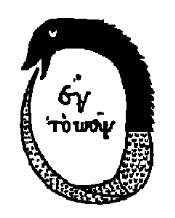
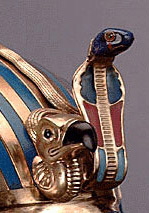
– The Uraeus was the symbol of sovereignty, worn on the royal Egyptian headdress. It is used as a protective symbol, as the Egyptians believed that the cobra would spit fire at any approaching enemies.
– Wadjet was an Egyptian serpent guardian sent by Osiris to protect Pharoah and control the Nile. The cobra goddess was the patroness of Lower Egypt. Wadjet was part of the Osirian myths and was always viewed as a protector of Egypt, depicted as a woman with a cobra head or as a cobra about to strike at the nation’s enemies.
References:
Books –
1. Ultimate Encyclopedia of Mythology
by Arthur Cotterell & Rachel Storm
Websites –
> Ancient Egypt: The Mythology – Apep
> Wadjet, Goddess of Lower Egypt
> What IS the ouroboros?
> Apep, Water Snake-Demon of Chaos, Enemy of Ra…
Famous Iranian Dragons
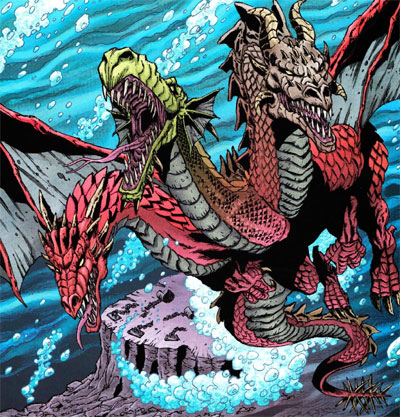
– Azhi Dahaka was a monstrous dragon and was said to have three heads, six eyes, and three pairs of fangs. He was sometimes regarded as a mythical king of Babylon. Originally, he killed cattle and men, but there are many diverse versions, one being the hero Feridun’s encounter with the dragon. In time, Azhi Dahaka came to be seen as the embodiment of falsehood and the servant of Angra Mainyu, the principle of darkness.
Atar, the fire god, and the dragon engaged in a bloody battle that took place over land, sea and air. The fire god eventually caught and chained the dragon to a mountain. Azhi Dahaka was believed to be able to break free during the end of the world, but that would be the time the hero Keresaspa would finally vanquish the beast.
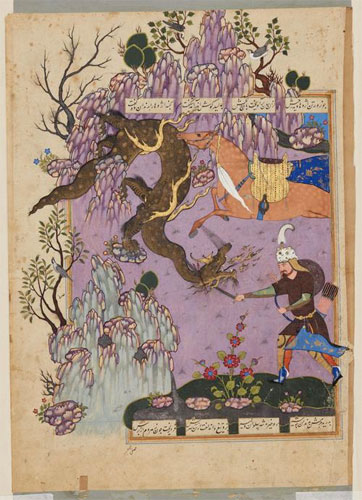
– Rustam and the dragon is a tale from a Shah-nama which originated in Persia around 1575.
A hero named Rustam and his horse, Rakhsh were on their way to the Mazanderan River to deliver the foolish King Kai Kaus of Persia from an army of demons. On the first night of their journey a lion appeared with the intent of eating Rustam. Rakhsh saved his master by killing the lion. When Rustam awoke and saw the lion’s body he thanked Rakhsh for saving his life but told the horse to wake him up next time so as not to endanger the horse’s life.
They had to cross a great stretch of desert and at day’s end they came to a spring, quenched their thirst and went directly to sleep. That night the dragon who guarded the spring came out of hiding to kill the hero and his horse. Rakhsh woke his master who sprang up from his slumber and grabbed his sword. The dragon had slipped back into hiding and Rustam scolded his horse for waking him up for nothing. Again the dragon slurked out of its hiding place and again the horse woke his master, and again the dragon slipped back into hiding before Rustam saw it. This time he was really mad at his horse. The third time the dragon came out Rakhsh didn’t know what to do, and it wasn’t until the last second that he roused his master. Rustam sprang up furiously, but this time the dragon was too close to escape and Rustam slew it.
Middle Eastern Dragons, References:
Books: Ultimate Encyclopedia of Mythology by Arthur Cotterell & Rachel Storm
Websites:
> Gateways to Babylon
> Prehistory of Memory
> Rustam and Dragon
> The Detroit Institute of Arts

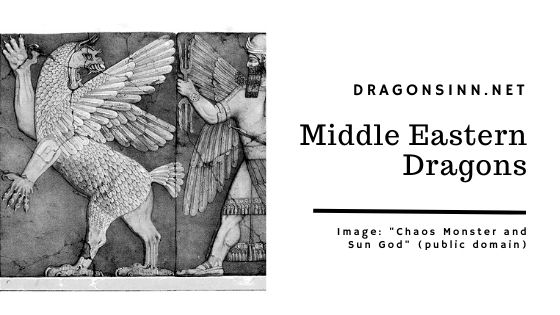
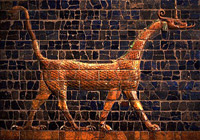
One reply on “Middle Eastern Dragons”
[…] Learn more about the history of Middle Eastern dragons and famous Middle Eastern dragons. […]